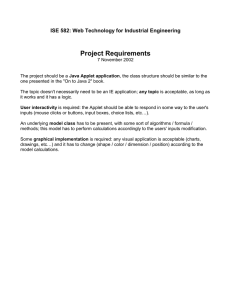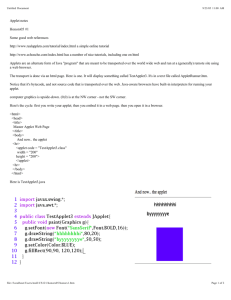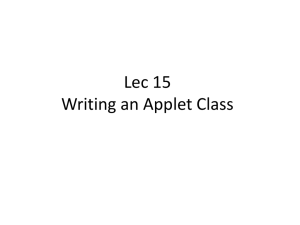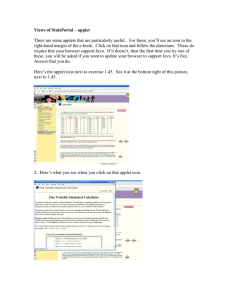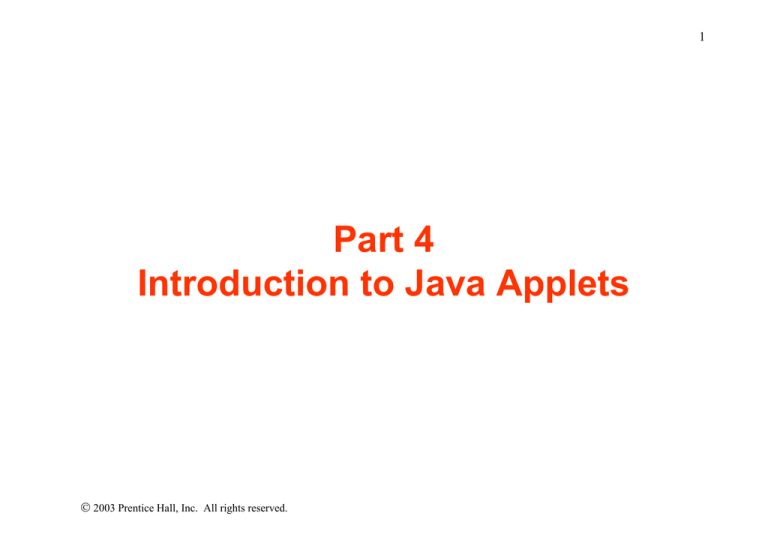
1
Part 4
Introduction to Java Applets
2003 Prentice Hall, Inc. All rights reserved.
3
3.1
Introduction
• Applet
– Program that runs in
• appletviewer (test utility for applets)
• Web browser (IE, Communicator)
– Browser that executes applet is called applet container.
– Executes when HTML (Hypertext Markup Language)
document containing applet is opened and downloaded
– Applications run in command windows
• Notes
– Mimic several features of Chapter 2 to reinforce them
– Focus on fundamental programming concepts first
• Explanations will come later
3.2
Sample Applets from the Java 2
Software Development Kit
• Sample Applets
– Provided in Java 2 Software Development Kit (J2SDK)
– Source code included (.java files)
• Study and mimic source code to learn new features
• All programmers begin by mimicking existing programs
– Located in demo directory of J2SDK install
– Can download demos and J2SDK from
java.sun.com/j2se/1.4.1/
4
3.2
Sample Applets from the Java 2
Software Development Kit
• Running applets
– In command prompt, change to demo subdirectory of applet
cd c:\j2sdk1.4.1\demo\applets
cd appletDirectoryName
– There will be an HTML file used to execute applet
– Type appletviewer example1.html
• appletviewer loads the html file specified as its commandline argument
• From the HTML file, determines which applet to load (more
section 3.3)
– Applet will run, Reload and Quit commands under Applet
menu
5
3.2
Sample Applets from the Java 2
Software Development Kit
• You start as player "X"
Fig. 3.2
Sample execution of applet TicTacToe.
6
3.2
Sample Applets from the Java 2
Software Development Kit
Fig. 3.4
Sample execution of applet DrawTest.
Drag the mouse pointer
in the white area to draw.
Select the
drawing color by clicking
the circle for the color
you want. These GUI
components are
commonly known as
radio buttons.
Select the shape to draw
by clicking the down
arrow, then clicking
Lines or Points. This
GUI component is
commonly known as a
combo box, choice or
drop-down list.
7
3.2
•
Sample Applets from the Java 2
Software Development Kit
Demonstrates 2D drawing capabilities built into Java2
Click a tab to
select a
twodimensional
graphics
demo.
Try changing
the options to
see their effect
on the
demonstration.
8
9
3.3
Simple Java Applet: Drawing a String
• Now, create applets of our own
– Take a while before we can write applets like in the demos
– Cover many of same techniques
• Upcoming program
– Create an applet to display
"Welcome to Java Programming!"
– Show applet and HTML file, then discuss them line by line
1
2
3
4
5
6
7
8
9
10
11
12
13
14
15
16
17
18
19
20
21
// Fig. 3.6: WelcomeApplet.java
// A first applet in Java.
// Java packages
import java.awt.Graphics;
import javax.swing.JApplet;
import allows us to use
predefined classes (allowing
us to use applets and
import
class Graphics
graphics,
in this case).
//
// import class JApplet
Outline
Java applet
public class WelcomeApplet extends JApplet {
extends allows us to inherit the
// draw text on applet’s background
public void paint( Graphics g )
capabilities of class JApplet.
{
// call superclass version of method paint
super.paint( g );
// draw a String at x-coordinate 25 and y-coordinate 25
g.drawString( "Welcome to Java Programming!", 25, 25 );
} // end method paint
} // end class WelcomeApplet
Method paint is guaranteed to
be called in all applets. Its first
line must be defined as above.
Program Output
2003 Prentice Hall, Inc.
All rights reserved.
10
11
3.3
1
2
Simple Java Applet: Drawing a String
// Fig. 3.6: WelcomeApplet.java
// A first applet in Java.
– Comments
• Name of source code and description of applet
5
6
import java.awt.Graphics;
import javax.swing.JApplet;
// import class Graphics
// import class JApplet
– Import predefined classes grouped into packages
• import declarations tell compiler where to locate classes
used
• When you create applets, import the JApplet class
(package javax.swing)
• import the Graphics class (package java.awt) to draw
graphics
– Can draw lines, rectangles ovals, strings of characters
• import specifies directory structure
12
3.3
Simple Java Applet: Drawing a String
– Applets have at least one class declaration (like applications)
• Rarely create classes from scratch
– Use pieces of existing classes
– Inheritance - create new classes from old ones (ch. 9)
8
public class WelcomeApplet extends JApplet {
– Begins class declaration for class WelcomeApplet
• Keyword class then class name
– extends followed by class name
• Indicates class to extend (JApplet)
– JApplet : superclass (base class)
– WelcomeApplet : subclass (derived class)
• WelcomeApplet now has methods and data of JApplet
13
3.3
8
Simple Java Applet: Drawing a String
public class WelcomeApplet extends JApplet {
– Class JApplet defined for us
• Someone else defined "what it means to be an applet"
– Applets require over 200 methods!
• extends JApplet
– Inherit methods, do not have to declare them all
• Do not need to know every detail of class JApplet
14
3.3
8
Simple Java Applet: Drawing a String
public class WelcomeApplet extends JApplet {
– Class WelcomeApplet is a blueprint
• appletviewer or browser creates an object of class
WelcomeApplet
– Keyword public required
– File can only have one public class
– public class name must be file name
15
3.3
11
Simple Java Applet: Drawing a String
public void paint( Graphics g )
– Our class inherits method paint from JApplet
• By default, paint has empty body
• Override (redefine) paint in our class
– Methods paint, init, and start
• Guaranteed to be called automatically
• Our applet gets "free" version of these by inheriting from
JApplet
– Free versions have empty body (do nothing)
– Every applet does not need all three methods
• Override the ones you need
– Applet container “draws itself” by calling method paint
16
3.3
11
Simple Java Applet: Drawing a String
public void paint( Graphics g )
– Method paint
• Lines 11-19 are the declaration of paint
• Draws graphics on screen
• void indicates paint returns nothing when finishes task
• Parenthesis define parameter list - where methods receive data
to perform tasks
– Normally, data passed by programmer, as in
JOptionPane.showMessageDialog
• paint gets parameters automatically
– Graphics object used by paint
• Mimic paint's first line
17
3.3
14
Simple Java Applet: Drawing a String
super.paint( g );
– Calls version of method paint from superclass JApplet
– Should be first statement in every applet’s paint method
17
g.drawString( "Welcome to Java Programming!", 25, 25 );
– Body of paint
• Method drawString (of class Graphics)
• Called using Graphics object g and dot (.)
• Method name, then parenthesis with arguments
– First argument: String to draw
– Second: x coordinate (in pixels) location
– Third: y coordinate (in pixels) location
– Java coordinate system
• Measured in pixels (picture elements)
• Upper left is (0,0)
18
3.3
Simple Java Applet: Drawing a String
• Running the applet
– Compile
• javac WelcomeApplet.java
• If no errors, bytecodes stored in WelcomeApplet.class
– Create an HTML file
• Loads the applet into appletviewer or a browser
• Ends in .htm or .html
– To execute an applet
• Create an HTML file indicating which applet the browser (or
appletviewer) should load and execute
19
3.3
1
2
3
4
Simple Java Applet: Drawing a String
<html>
<applet code = "WelcomeApplet.class" width = "300" height = "45">
</applet>
</html>
– Simple HTML file (WelcomeApplet.html)
• Usually in same directory as .class file
• Remember, .class file created after compilation
– HTML codes (tags)
• Usually come in pairs
• Begin with < and end with >
– Lines 1 and 4 - begin and end the HTML tags
– Line 2 - begins <applet> tag
• Specifies code to use for applet
• Specifies width and height of display area in pixels
– Line 3 - ends <applet> tag
20
3.3
1
2
3
4
Simple Java Applet: Drawing a String
<html>
<applet code = "WelcomeApplet.class" width = "300" height = "45">
</applet>
</html>
– appletviewer only understands <applet> tags
• Ignores everything else
• Minimal browser
– Executing the applet
• appletviewer WelcomeApplet.html
• Perform in directory containing .class file
21
3.3
Simple Java Applet: Drawing a String
• Running the applet in a Web browser
22
3.4
Drawing Strings and Lines
• More applets
– First example
• Display two lines of text
• Use drawString to simulate a new line with two
drawString statements
– Second example
• Method g.drawLine(x1, y1, x2, y2 )
– Draws a line from (x1, y1) to (x2, y2)
– Remember that (0, 0) is upper left
• Use drawLine to draw a line beneath and above a string
1
2
3
4
5
6
7
8
9
10
11
12
13
14
15
16
17
18
19
20
21
22
// Fig. 3.9: WelcomeApplet2.java
// Displaying multiple strings in an applet.
// Java packages
import java.awt.Graphics;
import javax.swing.JApplet;
// import class Graphics
// import class JApplet
public class WelcomeApplet2 extends JApplet {
// draw text on applet’s background
public void paint( Graphics g )
{
// call superclass version of method paint
super.paint( g );
// draw two Strings at different locations
g.drawString( "Welcome to", 25, 25 );
g.drawString( "Java Programming!", 25, 40 );
Outline
WelcomeApplet2.j
ava
1. import
2. Class
WelcomeApplet2
(extends
JApplet)
3. paint
3.1 drawString
} // end method paint
} // end class WelcomeApplet2
23
The two drawString3.2 drawString
on same In
x coordinate,
statements simulate a newline.
butof15
pixels down
fact, the concept of lines
text
does not exist when drawing
strings.
2003 Prentice Hall, Inc.
All rights reserved.
Outline
1
2
3
4
<html>
<applet code = "WelcomeApplet2.class" width = "300" height = "60">
</applet>
</html>
HTML file
Program Output
2003 Prentice Hall, Inc.
All rights reserved.
24
1
2
3
4
5
6
7
8
9
10
11
12
13
14
15
16
17
18
19
20
21
22
23
24
25
26
27
// Fig. 3.11: WelcomeLines.java
// Displaying text and lines
// Java packages
import java.awt.Graphics;
import javax.swing.JApplet;
// import class Graphics
// import class JApplet
public class WelcomeLines extends JApplet {
// draw lines and a string on applet’s background
public void paint( Graphics g )
{
// call superclass version of method paint
super.paint( g );
// draw horizontal line from (15, 10) to (210, 10)
g.drawLine( 15, 10, 210, 10 );
// draw horizontal line from (15, 30) to (210, 30)
g.drawLine( 15, 30, 210, 30 );
// draw String between lines at location (25, 25)
g.drawString( "Welcome to Java Programming!", 25, 25 );
Outline
25
WelcomeLines.ja
va
2. Class
WelcomeLines
(extends
JApplet)
3. paint
3.1 drawLine
3.2 drawLine
Draw horizontal lines with
drawLine (endpoints
have same
3.3 drawString
y coordinate).
} // end method paint
} // end class WelcomeLines
Program Output
2003 Prentice Hall, Inc.
All rights reserved.
1
2
3
4
<html>
<applet code = "WelcomeLines.class" width = "300" height = "40">
</applet>
</html>
Outline
HTML file
2003 Prentice Hall, Inc.
All rights reserved.
26
27
3.4
Drawing Strings and Lines
• Method drawLine of class Graphics
– Takes as arguments Graphics object and line’s end points
– x and y coordinate of first endpoint
– x and y coordinate of second endpoint
28
3.5
Adding Floating-Point Numbers
• Next applet
– Mimics application for adding two integers (Fig 2.9)
• This time, use floating point numbers (numbers with a decimal
point)
– Using primitive types
• double – double precision floating-point numbers
• float – single precision floating-point numbers
– Show program, then discuss
1
2
3
4
5
6
7
8
9
10
11
12
13
14
15
16
17
18
19
20
21
22
23
24
25
26
27
28
29
30
31
2
3
5
6
7
8
9
10
11
12
13
14
15
16
17
18
19
20
21
22
23
24
25
Outline
// Fig. 3.13: AdditionApplet.java
// Adding
Adding tw
o floating-point
numbers.
//
two
floating-point
numbers
import java.awt.Graphics;
// import class Graphics
// Java packages
import java.awt.Graphics;
// import class Graphics
import javax.swing.*;
// extends
import package
public
class AdditionApplet
JAppletjavax.swing
{
double sum;
29
// sum of the values entered by the user
public class AdditionApplet extends JApplet {
double sum; // sum of values entered by user
public void init()
* allows any class in the
{
// initialize applet by obtaining valuespackage
from user
to be used.
String firstNumber,
// first string entered
by user
public void init()
secondNumber; // second string entered by user
{
doublefirstNumber;
number1,
// first
number
to add
String
// first
string
entered
by user
number2;
//
second
number
to
String secondNumber; // second string entered add
by user
Field sum may be used anywhere
// read
in first number
fromnumber
user to add
double
number1;
// first
in the class, even in other methods.
firstNumber
=
double
number2;
// second number to add
JOptionPane.showInputDialog( Type double can store floating
// obtain
first first
numberfloating-point
from user
"Enter
value"
);
point
numbers.
firstNumber = JOptionPane.showInputDialog(
first
floating-point
value"
//"Enter
read in
second
number from
user);
secondNumber =
// obtain
second number from user
JOptionPane.showInputDialog(
secondNumber = JOptionPane.showInputDialog(
"Enter second floating-point value" );
"Enter second floating-point value" );
AdditionApplet.
java
1. import
2. Class
AdditionApplet
(extends
JApplet)
3. Fields
4. init
4.1 Declare variables
4.2
showInputDialog
4.3 parseDouble
// convert numbers from type String to type double
number1 = Double.parseDouble( firstNumber );
number2 = Double.parseDouble( secondNumber );
2003 Prentice Hall, Inc.
All rights reserved.
Outline
32
33
34
35
36
37
31
35
public
void paint(
Graphics on
g )applet’s background
//
draw results
in a rectangle
38
39
40
41
42
43
44
45
46
47
48
49
50
51
52
36
{
public
void paint( Graphics g )
{
// draw the results with g.drawString
//
call superclass
version
paint
g.drawRect(
15, 10,
270,of20method
);
super.paint( g );
1
2
3
4
//
//add
addnumbers
the numbers
sum
+ number2;
sum= =number1
number1
+ number2;
32
33
}
} // end method init
34
37
38
39
g.drawString( "The sum is " + sum, 25, 25 );
40
}
41 }
1
2
3
4
5. Draw applet
contents
5.1 Draw a rectangle
5.2 Draw the results
// draw rectangle starting from (15, 10) that is 270
// pixels wide and 20 pixels tall
g.drawRect( 15, 10, 270, 20 );
<html>
<applet
code="AdditionApplet.class"
width=300
height=50>
// draw
results as a String at (25,
25)
</applet>
g.drawString( "The sum is " + sum, 25, 25 );
</html>
} // end method paint
} // end class AdditionApplet
30
drawRect takes the upper left coordinate, width,
and height of the rectangle to draw.
HTML file
<html>
<applet code = "AdditionApplet.class" width = "300" height = "65">
</applet>
</html>
2003 Prentice Hall, Inc.
All rights reserved.
Outline
Program Output
2003 Prentice Hall, Inc.
All rights reserved.
31
32
3.5
Adding Floating-Point Numbers
– Lines 1-2: Comments
5
import java.awt.Graphics;
// import class Graphics
– Line 5: imports class Graphics
• import not needed if use full package and class name
public void paint ( java.awt.Graphics g )
6
import javax.swing.*;
// import package javax.swing
– Line 8: specify entire javax.swing package
• * indicates all classes in javax.swing are available
– Includes JApplet and JOptionPane
– Use JOptionPane instead of
javax.swing.JOptionPane
• * does not not load all classes
– Compiler only loads classes it uses
33
3.5
8
Adding Floating-Point Numbers
public class AdditionApplet extends JApplet {
– Begin class declaration
• Extend JApplet, imported from package javax.swing
9
double sum;
// sum of values entered by user
– Field declaration
• Each object of class gets own copy of the field
• Declared in body of class, but not inside methods
– Variables declared in methods are local variables
– Can only be used in body of method
• Fields can be used anywhere in class
• Have default value (0.0 in this case)
• Fields are also known as instance variables.
Explicitly initializing fields rather than
relying on automatic initialization
improves program readability.
34
3.5
9
Adding Floating-Point Numbers
double sum;
// sum of values entered by user
– Primitive type double
• Used to store floating point (decimal) numbers
12
public void init()
– Method init
• Normally initializes fields and applet class
• Guaranteed to be first method called in applet
• First line must always appear as above
– Returns nothing (void), takes no arguments
13
{
– Begins body of method init
35
3.5
14
15
16
17
18
Adding Floating-Point Numbers
String firstNumber;
String secondNumber;
// first string entered by user
// second string entered by user
double number1;
double number2;
// first number to add
// second number to add
– Declare variables
– Two types of variables
• Reference variables (called references)
– Refer to objects (contain location in memory)
• Objects defined in a class definition
• Can contain multiple data and methods
– paint receives a reference called g to a Graphics
object
– Reference used to call methods on the Graphics object
• Primitive types (called variables)
– Contain one piece of data
– Boolean, char, byte, short, int, long, float, and double
36
3.5
14
15
16
17
18
Adding Floating-Point Numbers
String firstNumber;
String secondNumber;
// first string entered by user
// second string entered by user
double number1;
double number2;
// first number to add
// second number to add
– Distinguishing references and variables
• If type is a class name, then reference
– String is a class
– firstNumber, secondNumber
• If type a primitive type, then variable
– double is a primitive type
– number1, number2
37
3.5
21
22
Adding Floating-Point Numbers
firstNumber = JOptionPane.showInputDialog(
"Enter first floating-point value" );
• Method JOptionPane.showInputDialog
• Prompts user for input with string
• Enter value in text field, click OK
– If not of correct type, error occurs
– In Chapter 15 learn how to deal with this
• Returns string user inputs
• Assignment statement to string
– Lines 25-26: As above, assigns input to secondNumber
38
3.5
29
30
Adding Floating-Point Numbers
number1 = Double.parseDouble( firstNumber );
number2 = Double.parseDouble( secondNumber );
– static method Double.parseDouble
• Converts String argument to a double
• Returns the double value
• Remember static method syntax
– ClassName.methodName( arguments )
33
sum = number1 + number2;
– Assignment statement
• sum a field, can use anywhere in class
– Not defined in init but still used
39
3.5
35
Adding Floating-Point Numbers
} // end method init
– Ends method init
• appletviewer (or browser) calls inherited method start
• start usually used with multithreading
– Advanced concept, in Chapter 16
– We do not declare it, so empty declaration in JApplet
used
• Next, method paint called
45
g.drawRect( 15, 10, 270, 20 );
– Method drawRect( x1, y1, width, height )
• Draw rectangle, upper left corner (x1, y1), specified width
and height
• Line 45 draws rectangle starting at (15, 10) with a width of 270
pixels and a height of 20 pixels
40
3.5
48
Adding Floating-Point Numbers
g.drawString( "The sum is " + sum, 25, 25 );
– Sends drawString message (calls method) to Graphics
object using reference g
• "The sum is" + sum - string concatenation
– sum converted to a string
• sum can be used, even though not defined in paint
– field, can be used anywhere in class
– Non-local variable in method drawString
3.6
Java Applet Internet and World Wide
Web Resources
• Many Java applet resources available
– java.sun.com/applets/
– Many resources and free applets
• Has demo applets from J2SDK
– Sun site developer.java.sun.com/developer
• Tech support, discussion forums, training, articles, links, etc.
• Registration required
– www.jars.com
• Rates applets, top 1, 5 and 25 percent
• View best applets on web
41
42
Summary
Applets
• Program that runs in
– appletviewer (test utility for applets)
– Web browser (IE, Communicator)
• Browser that executes applet is called applet
container.
• Executes when HTML (Hypertext Markup
Language) document containing applet is opened
and downloaded
• Applications run in command windows

